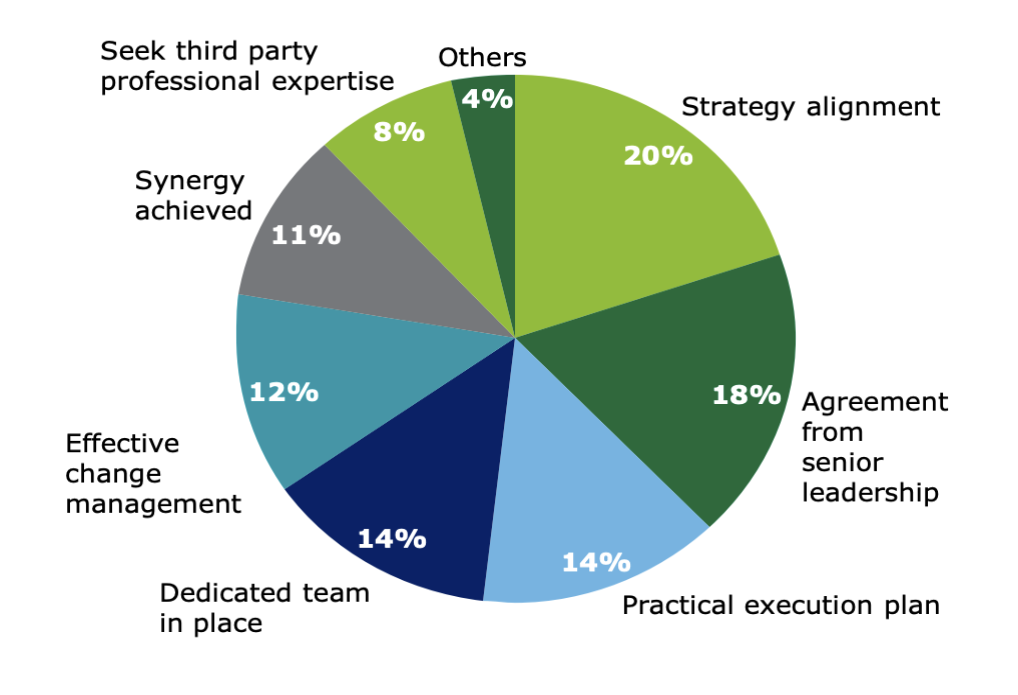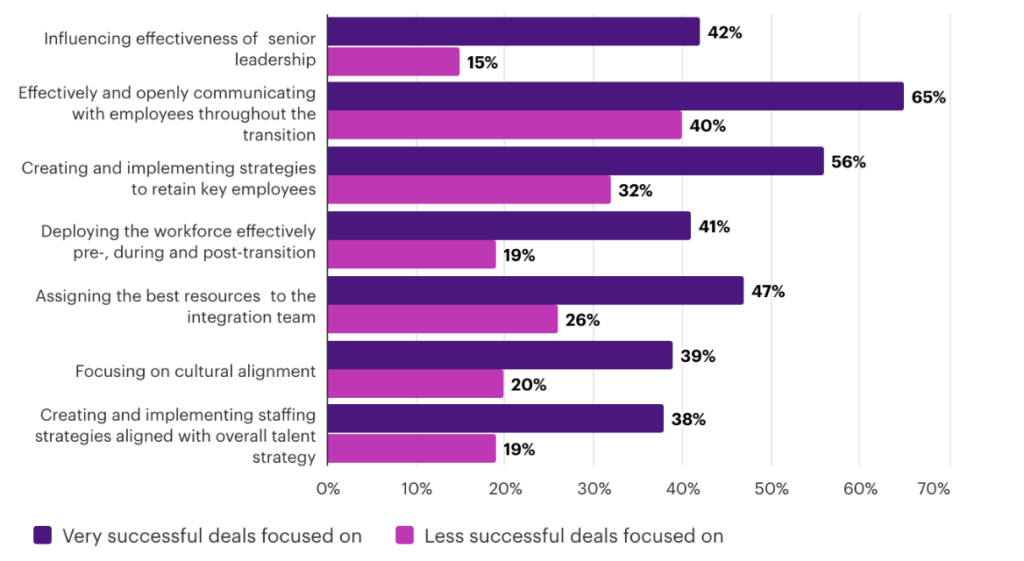Poorly planned post-merger integration is a common reason for deal failure in mergers and acquisitions. According to one study, cultural differences between two companies that occur during the transition phase lead to deal failure in 41% of cases.
The solution to this challenge is to implement effective post-merger integration change management.
In this article, we focus on the basics of M&A change management and suggest best practices to carry out this process effectively.
The essence of M&A change management
Change management is an important part of the post-merger integration phase. It’s the process that involves the implementation of certain tactics and approaches to manage the change the merging companies face.
Essentially, M&A integration change management is the process of ensuring a smooth transition after the transaction. It involves managing employees’ expectations, winning stakeholders’ buy-in, and orienting them through the transition.
As stated by PwC’s 2023 M&A Integration Survey, Fortune 1000 management teams named the following elements as the key drivers of their change management programs:

The function of change management in M&A
The key function of change management during M&A is to ensure that the acquiring and acquired companies successfully merge and achieve expected synergies. The process must consider factors such as existing cultures, operations, communications, and leadership structures.
A recent Deloitte survey found that effective change management was ranked as a critical factor for successful post-merger integration.

Mergers and acquisitions change management is an integral part of the post-merger integration plan as it helps to:
- Minimize disruptions
A thorough change management plan enables a company to avoid the risk of disruptions in day-to-day operations, as well as the overall negative impact on employees’ productivity and morale.
- Manage resistance
Employees can often be resistant to a new corporate culture or operating model, as the change can cause feelings of uncertainty. Change management helps to overcome this issue by including a resistance analysis that identifies potential problems and how to address them.
- Preserve culture and values
During the transition process, there’s a risk for companies (often, the target company) to lose their unique culture or to have it diluted. Change management helps to prevent that by preserving and strengthening organizational culture and ensuring transparent communication at all levels.
- Maintain customer satisfaction
The transition phase can disrupt or negatively impact customer service. Change management helps to preserve an uninterrupted customer experience and maintain general customer satisfaction and loyalty.
- Ensure efficient integration
Change management provides a structured framework for planning, executing, and evaluating the integration process, making it more efficient and reducing problems.
Preparing for change in the main 6 steps
So, where to start with M&A change management? Let’s discuss the main preparatory steps to be taken before the process rolls out.
1. Define the change objectives
Transition planning starts with the understanding of what goals you want to achieve. This will help all the participants and responsible parties move in the same direction when managing change and have a clear vision of what results they have to achieve.
Define the objectives of the change management program, outline desired outcomes, and specify how success will be measured.
2. Assess current state
To define the key areas for change, there first has to be a change readiness assessment. This is the process of evaluating how ready and prepared the entire organization is for change.
Additionally, the current state of the organization’s affairs should be assessed. This also helps determine what actions should be taken in each area of business operations to achieve desired change objectives.
3. Identify key stakeholders
A stakeholder analysis helps to identify all stakeholders that will be affected by the change. It includes employees, the senior leadership team, customers, suppliers, and all other relevant participants of the transition phase.
To ensure a smooth integration and effective change management, you should understand their perspectives, concerns, and potential resistance to change.
4. Communicate the need for change
All stakeholders should be aware of the upcoming changes, how they’re going to impact the current operations, and what to expect in the company’s future.
For this, create a comprehensive communication plan, that involves communication strategies, communication channels, and the list of stakeholders. Doing so will help to win stakeholders’ buy-in and minimize resistance.
The main reason behind a well-developed communication plan is to inform all the relevant parties about the need for change, the purpose behind it, and its potential benefits.
5. Establish a change management team
A change management team or integration management office is an assembled team of people who are responsible for overseeing the change management process.
The team typically consists of employees from different departments and levels within an organization to ensure that diverse perspectives are considered. It’s a mistake to put this responsibility solely on the HR department.
6. Develop a change management plan
Finally, develop a comprehensive change management plan that outlines the findings you have after conducting previous steps.
It should include specific steps, timelines, resources, and responsibilities associated with the change initiative. Additionally, it should address potential risks and conflict resolution strategies. Such a plan should provide all the parties involved with a clear vision of the direction they should move to, guiding the entire combined organization through the change process.
Developing the right change management strategy: 6 main components
An effective change management strategy should address the following components:
- Assessment and planning
- Communication plans
- Leadership alignment
- Employee engagement initiatives
- Training and development
- Measurement and evaluation
Let’s now take a closer look at what each of these components involves.
Assessment and planning
- Conducting a thorough evaluation of the need for change, including the reasons behind it, potential risks, and expected outcomes.
- Developing a detailed change management plan that outlines the scope, timelines, objectives, resources, and responsibilities for the change management process.
Communication plans
- Creating a comprehensive communication plan that specifies how information about the change will be delivered to stakeholders and other relevant parties.
- Identifying key messages, communication channels, and frequency of communication to keep stakeholders informed and engaged throughout the entire transition process.
- Tailor communication strategies to different audiences: employee groups, customers, clients, suppliers, leadership teams, and other stakeholders.
Leadership alignment
- Specifying the tactics that will help to ensure alignment among senior leadership teams and key decision-makers regarding the vision and objectives of the change management process.
- Engaging leaders in the change management process and providing them with the necessary support, resources, and training to effectively lead their teams through the transition phase.
- Fostering a culture of open communication among leadership teams to facilitate decision-making and problem-solving during the change management process.
Employee engagement initiatives
- Ensuring employees’ engagement early in the change process by soliciting their feedback and ideas for improvement.
- Providing employees with opportunities to engage in decision-making and contribute to the change management process at the relevant levels.
- Implementing such employee engagement initiatives as town hall meetings, surveys, focus groups, and feedback mechanisms to ensure that all the change information is communicated, and employee concerns are heard and addressed.
Training and development
- Identifying any skills gaps or training needs that might occur in the process of change and developing target training programs.
- Providing employees with the necessary knowledge and resources to help them adapt to the new culture, processes, and operations.
- Offering ongoing support and training to help employee groups navigate the change effectively.
Progress measurement and evaluation
- Defining the key performance indicators (KPIs) and metrics to measure the success of the change process.
- Regularly monitoring and assessing the progress of KPI completion and making relevant adjustments if necessary.
- Regularly collecting feedback from stakeholders to evaluate their perception of change and identify areas for improvement.
Note: To learn more about winning strategies for M&A read our dedicated article.
The role of effective communication during M&A change management
Transparent communication with employees during a transition period is among the most crucial factors for post-integration success.
According to Leadership IQ’s survey, only 15% of employees always understand the rationale behind their leaders’ strategy. Such findings can result in a loss of motivation among employees and cause some of them to leave the organization. This, in turn, can lead to a talent retention problem.
Note: Explore the general risks of mergers and acquisitions in our dedicated article.
The importance of effective communication is also proven by WTW’s research, which shows that very successful deals typically have one thing in common: they pay great attention to clear and effective communication with employees during the transition.

Best practices for leadership and culture alignment
Research by Culture Amp found that mergers and acquisitions negatively impact employees’ perception of decision-making, alignment, and motivation.
At the same time, culture clashes are the reason for 30% of failed post-merger integrations, based on Deloitte’s findings.
This shows the importance of ensuring leadership and culture alignment during the transition phase. To do so, consider the following recommendations.
Conduct one-on-one interviews and focus group sessions
This helps to bring a more human aspect to the whole transition process.
Ensure that a responsible change manager conducts one-on-one interviews with senior employees (or with particular focus groups) to assess their readiness to change and learn about their fears and worries. This will help to identify ways to address those concerns and mitigate potential resistance risks.
Carry out surveys
Another way to evaluate leadership and employee perception of the whole change process is to conduct surveys.
Unlike one-on-one meetings, where employees might hesitate to share their thoughts openly, surveys allow for gathering honest feedback without putting a respondent under stress with face-to-face conversations.
Conduct a potential resistance analysis
Similar to one-on-one meetings, a potential resistance analysis helps to uncover how employees are feeling about change. The key focus here is to search for a “them and us” mentality, which prevents people from embracing change as a positive thing.
Present findings to stakeholders in a comprehensive report
The assessment’s findings should be presented in a well-drafted report, with key gaps and areas for improvement specified.
What’s more, it has to include calls to action and responsibilities assigned to relevant stakeholders.
Note: Discover the overall M&A best practices in our dedicated article.
How to measure the success of change management initiatives?
Here’s how you track the progress of the change management initiatives and assess their effectiveness:
- Ensure key KPIs are specified
Measuring success is only possible when there are clear KPIs in place. This way, you know what results are expected from the changed operating models. KPIs can include employee engagement levels, customer satisfaction levels, productivity, revenue growth, and cost savings.
- Establish regular monitoring and tracking
Continuously monitor and track the identified KPIs throughout the change management process. This allows for real-time assessment of progress and early identification of any issues or challenges that may arise.
- Collect feedback
Perform a change impact analysis and gather feedback from stakeholders and all the relevant parties to assess their perception of change and its impact. This can be done through surveys, focus group sessions, one-on-one meetings, and other feedback-sharing mechanisms.
- Compare results to goals
With the results of the assessment ready, the change management team can then compare them with the predetermined KPIs and overall change objectives. This allows for identifying success areas and those where certain challenges or obstacles have been identified.
- Conduct a root cause analysis
To understand the underlying factors contributing to the observed results, perform a root cause analysis. This helps to identify all the barriers and gaps that prevent the merging organizations from achieving predetermined change objectives.
- Make adjustments
Based on the findings, make the necessary adjustments to the change management process. This could involve refining strategies, providing additional support or training, and revising timelines.
- Communicate changes and progress
To ensure a transparent process, communicate all the changes and progress to stakeholders. This will keep them informed about changes or improvements and help to foster their trust and confidence in the change management process.
Key takeaways
- M&A change management is the process of implementing certain tactics and approaches to ensure a smooth transition during the post-merger integration phase.
- The key function of change management is to ensure that existing cultures, operations, communications, and leadership structures of two companies successfully merge in a way that helps the combined company achieve expected synergies.
- The main components of the right change management strategy include assessment and planning, communication plans, leadership alignment, employee engagement initiatives, training and development, and measurement and evaluation.



